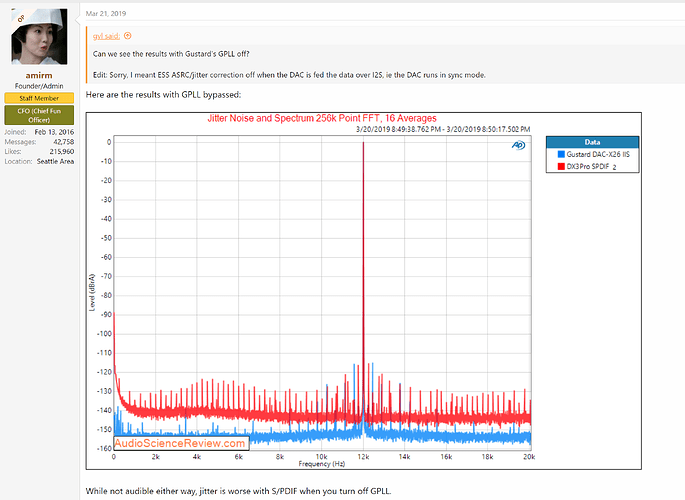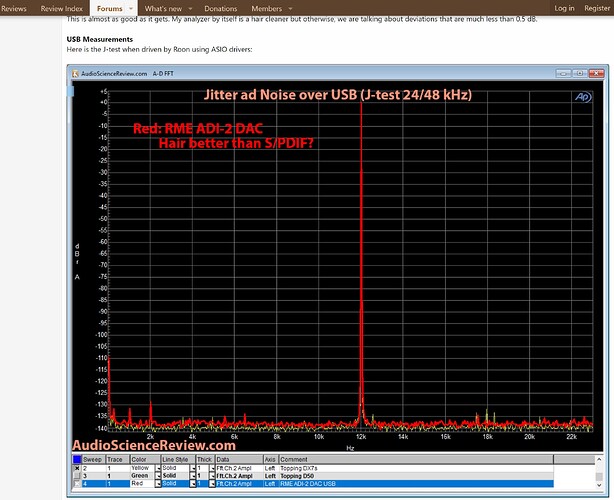Thanks for all the replies. I know a lot of the acoustic stuff is scientifically discovered before the 80’s. My Yamaha speakers are from the 70-s and my Threshold amp from the 80-s and I also think “what the hell have they been doing these last years”. The developments are up to boutique companies and they will not likely tell is what they found, even if it is not much. What are they thinking at Ansuz or Antipodes? I have always been very sceptical until I heard the difference, more than just once. Are these differences measurable? Some manufacturer showed Hans (in the video) that there is a work around. That is up to the scientists to make better measurement tools but first is to be known what exactly to measure. That is not up to the audiophile who is just listening to music, but to the manufacturer who is always struggling what to tell and not to reveal about the findings.
This argument simply doesn’t hold water because the engineers who make these “boutique” devices can only use the technologies and science that are currently available.
Unless you’re suggesting that they stumbled upon the infinite improbability drive? But then, if they had, controlled listening tests would reveal this.
I think audiophiles just mean good because they also want other people to enjoy better sound. There are even audiophile-engineers who explain what is going on, like Hans van Beekhuyzen. There are also engineers who first want to see proof of controlled listening tests by scientists before they hear for themselves. I have been a member of these 3 groups. I now blame the audio-industry in general for making it an elite business. To attend an audio show, one now has to buy tickets in advance. For every demo you have to make a reservation. There are hardly possibilities to listen to new audio stuff and compare.
I don’t know what Hans is or what groups he’s part of, but what he’s saying in his videos is neither engineering nor science.
On his website, he describes himself as a techniekjournalist. He’s a journalist, not an engineer, and this is evident when hearing some of his claims–or at least it is to engineers.
I suppose anyone who posts supposedly factual articles or videos these days is a “journalist”, whether or not those posts are actually factual or consistent or well-written/produced. The older qualifications – attended journalism school, worked for a news organization as a reporter – don’t seem to mean much anymore. It’s all about whether or not you’re selling ad views.
The audio industry has a vested interest in presenting good SQ as being rare and expensive, a kind of luxury good. Whereas in reality excellent gear is widely available inexpensively. If consumers understood that, half the companies in the audio industry would go under.
Exactly. I have waited and picked items that are both excellent in terms of measured performance as well as buying used when necessary. This way I put together a system that would be above my means new that I can enjoy for years to come.
Nothing in audio reproduction has been fully solved. Until usb audio does checksums on the data stream to detect errors and then allows correction of errors the problem with usb hasn’t been solved, it may be acceptable but there are many aspects of audio that are acceptable without them undergoing constant improvement.
The quest for perfect reproduction continues.
You gotta be kidding. Unless you have a faulty USB cable or a sparking Tesla coil nearby, USB audio bit errors are as rare as bit errors in any of the internal digital interconnects in your source or DAC, which are not checksummed. It baffles me that audiophiles keep imagining sources of distortion in their digital gear when everything analog, in the recording studio and from the DAC’s analog section downstream is where you should be looking for potential improvements.
They are, actually, there just aren’t provisions in UAC2 for retransmission of packets failing CRC check. But since CRC is there, it’s possible (and has been done) to evaluate error rates in audio transmission over USB.
With a spec compliant USB cable ,error rates are in order of 1 packet in several days of non-stop listening. This is not a problem.
It’s actually the other way around. Everything has been fully solved.
There’s no such thing as perfect reproduction, but we don’t need perfection, since our hearing is not perfect either. All we need is do better, and we’ve done much better. The only quest that continues is for audiophiles’ wallets.
The OP @Torben_Rick wanted to know if devices like the AirLens from PS Audio can improve sound quality. I have not heard the AirLens but shared that I believe that a properly designed streamer can have a positive impact on SQ. My Allo Digione Signature fed by COAX /SPDIF to my RME with a Shanti PS opened my eyes to this. Prior to that I was in disbelief. Bits are bits, or so I thought. This jitter and noise crap is just crap, right? Nope, I stand corrected. Also, some cables make a difference althought many might be snake oil… buyer beware.
What followed was a bunch of garbage from the objectivist, know it all’s, talking or hinting about ASRs measure-bating and slandering a good man, Paul McGowan.
Has anyone actually listened to the AirLens? It’s a shame that you would slander someone like Paul who has dedicated his life to this industry, writing several excellent books and providing answers to HiFi questions daily on YouTube. Check yourselves. Shame on you.
@Graeme_Finlayson I’m sorry about your COVID, I hope you are able to enjoy some scotch. McCallan 18 is my go-to when I can get it.
I am glad you posted that review from Amir @ASR. Every one of the DACs I’ve purchased have first been santiy checked at his site. I believe measurements are important but they don’t always have the final say for me. The issue I have with Amir is that he believes his equipment and testing processes are the scientific answer, period. Even when he makes a mistake like he did in the I2S review, he does not update his conclusions. For example:
But if you read in the comments that followed he realized he had misconfigured the sequence of the SU1.
You would think he would take back his conclusion after reposting that I2S was indeed better than the other interfaces. “Less Jitter” but “not audible” bc Amir says so. Silly me.
The other issue I take with Amir’s reviews is that his speaker tests are done in mono. He listens to one speaker. Because you know “soundstage” is just another audiophile myth.
Finally - does anyone else think it odd or just curious that Topping/SMSL have figured out how to create products that ACE Amir’s super duper test suite but sound like nothing special?
Let’s all agree to disagree on the whole objectivist vs. subjectivist BS, enjoy our systems and music. If any of you want to hear from actual HiFi designers and engineers check out https://www.thehifipodcast.net/.
Now who took my schnake oil?
@Henry_Svendblad Thanks for the kind words about my COVID. My sense of taste is returning, so I’m back to enjoying some peaty malts again.
I appreciate that Amir didn’t exactly get his measurement process right here, however, the highest peaks in the jiter induced sidebands on both devices are still around -115 dBFS. The remainder are below -120 dBFS, so he’s still right about the audibility.
To bring those peaks up to the absolutely lowest threshold of audibility, 0 dBFS would be playing at about 115 dB SPL. That’s well into permanent hearing damage range. Even if you could tolerate 115 dB SPL, you’d never hear 0 dB SPL (-115 dB below) due to masking. Human audibility thresholds are well-established and pretty much unanimously agreed upon by the whole science and engineering community. So, from a scientific and engineering perspective, the differences here truly are inaudible.
@Graeme_Finlayson, glad to hear you are better.
I think the issue with Amir is that he does this one or few tests and then that’s the GOSPEL, or settled science for too many. Because a SINAD test using a tone that nobody can hear is enough science, right? Science is gotta be better than just listening? If you look hard enough you’ll find other “Silly Me” examples like the I2S review that you posted earlier.
I think it you (or anyone) were to listen to A (USB) and then B (SPDIF) with low noise PS - whatever product that might be. You might agree or disagree with what Amir’s SINAD test said. Relying on Amir’s version of science as the absolute truth is at best misguided. Possibly dishonest based on some of his errors and omissions.
Per his test of my RME he found the USB performance as “a hair better” than the SPDIF. A much less expensive Topping DAC I also own tested better than my RME, do you really think it sounds better?
I bet… if I had those awesome speakers you built yourself in my room and with my AMP and DAC and we were sitting here sharing a scotch… would be nice. So… I’d bet you a bottle of scotch ![]() you would agree the SPDIF with the low noise PS is head and shoulders better in every way over USB in my system in my room. It’s not even close. How or why, I can only postulate… Or maybe you prefer a veiled and reduced soundstage?
you would agree the SPDIF with the low noise PS is head and shoulders better in every way over USB in my system in my room. It’s not even close. How or why, I can only postulate… Or maybe you prefer a veiled and reduced soundstage?
Paul says SPDIF and I2S are better than USB in his latest video. Interesting timing… I don’t just believe his subjective experience, like others believe in Amir’s science. I trust my own ears and I’m willing to listen before I make up my mind or go as far as slandering a decent man like Paul.
Something is broken with your DAC, maybe it is time to send it back and get a working one, seriously.
There is no way that SPDIF can sound better than USB in a DAC that is in a good state, and working.
You certainly must be right. By the way, have you heard the AirLens? Have you heard my DAC?
No, it is clear that it sounds broken by your own words.
One connection type is superior to the other. Simple as that. What else do you want to know? The USB connection does still sound better than other DACs I have. Nothing is broken but thank you for your concern.



